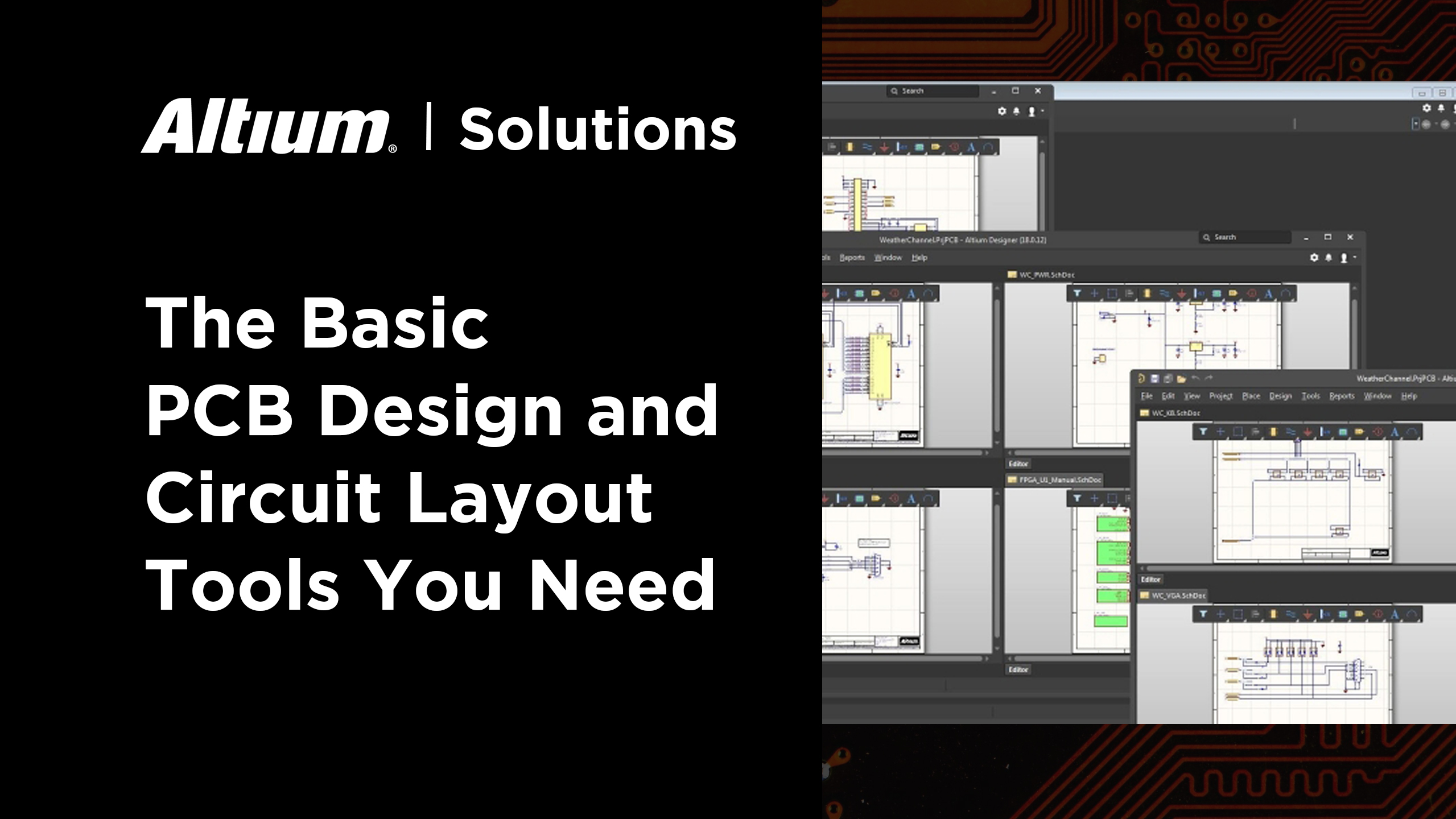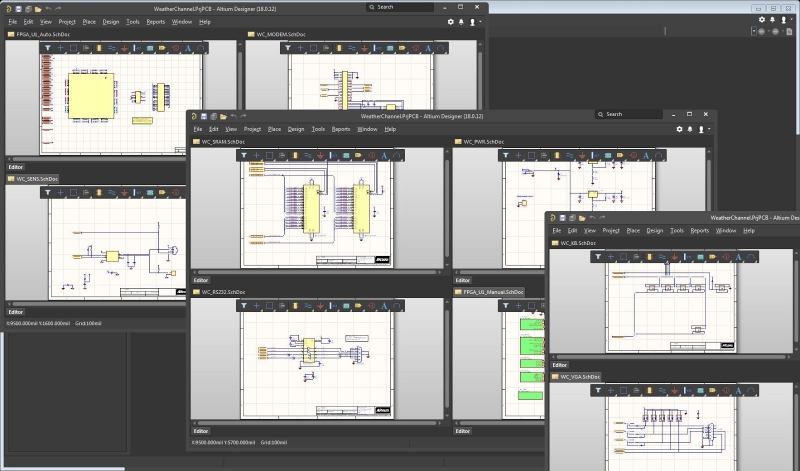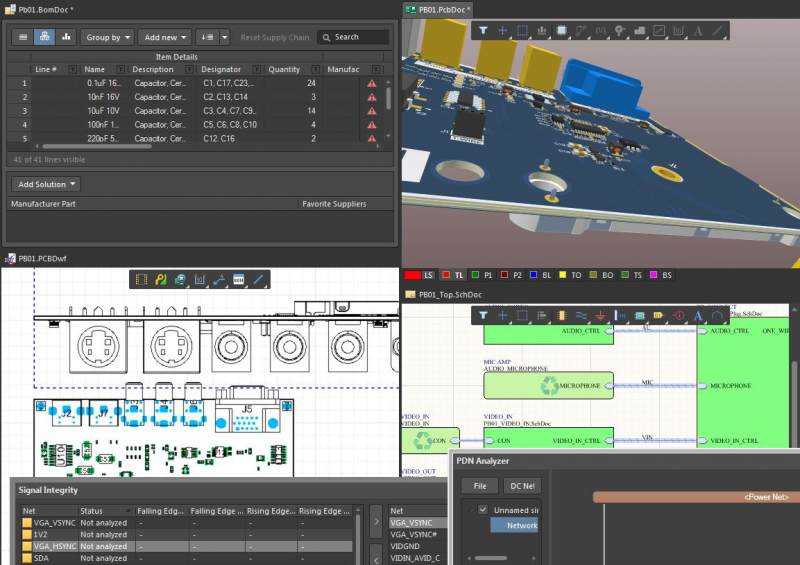Circuit CAD Software for PCB Design

Circuit CAD tools are the cornerstone of PCB design. These tools give you the capability to create schematics and a circuit board layout of your new product, but not all CAD features are created equal. Today’s designers need to take a comprehensive approach to PCB design that includes mechanical design, simulation, and preparation for manufacturing. Your productivity stays high when your CAD tools are integrated with more advanced design features and your other design tools, and you can quickly design PCBs for advanced applications.
To handle the complex challenges of a complete design project, you need a complete circuit CAD system for PCB design. Altium Designer offers all these advantages and many more in a single program. You’ll have everything you need to design your next PCB in a single program, including tools for MCAD collaboration in popular mechanical design applications.
ALTIUM DESIGNER
The most powerful, modern, and easy-to-use PCB design tool for professional use.
It’s true what they say: hardware is hard work. Compared to a new piece of software, building a new piece of hardware takes several iterations of building a proof of concept, prototyping, testing, retesting, and redesigning, not to mention any of the other aspects of marketing a new product.
If you’ve got a great idea for a new electronic device, you’ll need to turn it from a circuit diagram into a schematic. Later, you’ll need to turn your schematic into a layout, and then you’ll need to turn your layout into an actual PCB. The challenges of today’s complex designs require professional quality computer-aided design software tools. Too often in the past designers were forced to choose between settling for lesser quality tools, or mixing together tools from different systems in order to get the job done.
When all your design and production planning tools are integrated into a single application, you won’t have to worry about incorporating a third-party application into your design workflow. Altium Designer is a complete CAD software design system that will give you the resources you need for your greatest design challenges. From your initial schematic capture to your final manufacturing output data, all the tools you need for printed circuit board design are available in Altium Designer.
The Role of Circuit CAD Tools in PCB Design
CAD circuit design tools in your PCB design software do more than just allow you to place components on a board outline. Simpler circuit CAD software will give you these capabilities, but not much else. PCB CAD tools should not be limited to component layout in 2D board designs. Working with more advanced board configurations like rigid-flex design takes CAD tools that link multiple boards into a single device. The best CAD tools create a link between multiple layers on your board, allowing routing through vias and within the inner layers. Modern CAD tools give you a full view of your device and allow you to approach your design holistically.
The best CAD software will interface with a comprehensive set of design rules. These design rules govern the function of your routing features, simulation tools, and features for generating manufacturer deliverables. A rules-driven design engine in your circuit CAD software will automatically show you when you’ve created a rules violation, allowing you to fix any problems before you send your board off for manufacturing. A great CAD module forms the foundation for designing your next PCB, regardless of the application.
The Basic PCB Design and Circuit Layout Tools You Need
Your schematics define the basic structure of your device and provide the intimate details on how your components and power/ground lines are connected together in a coherent structure. Your new PCB starts its life in a powerful schematic editor, where CAD circuit tools are used to place and connect components together in a real device. The best schematic editors will include a SPICE-based simulator to evaluate the functionality of your circuits.
Once you finish your schematics, you’ll need to use a schematic capture utility to place your components into an initial PCB layout. You’ll then use CAD tools to arrange and route components together into a complete circuit board. The full layout of components on your PCB should feed directly into simulation and analysis features so that they can access information directly from your circuit CAD design. Accurate PCB layouts help ensure your manufacturer can build your board properly on the first production run, which prevents fabrication delays and redesigns.
- All designs start with schematic capture in your ECAD software. The best schematic design end editing features will include access to libraries you can use to find and place components into your schematic sheets.
Learn more about using your design software for schematic capture. - Hierarchical schematic design is a great way to keep each part of your device organized as it becomes more complicated.
Learn more about the difference between flat and hierarchical schematics. - Whether you’re designing a single multilayer board or a complex multi-board system, you need the right circuit CAD tools to complete your PCB layout.
Learn more about using your circuit CAD tools for advanced PCB layout.

Altium Designer’s powerful hierarchical schematic editor
Design Tools in Advanced CAD Software
Most freeware and online circuit CAD platforms include schematic editing, capture, and layout features, but they don’t include more advanced features. You’ll be forced to add other programs to your workflow if you want to understand your circuit board’s behavior and prepare for full-scale manufacturing. Post-layout simulation features are important for predicting signal integrity problems like crosstalk and ringing, and a set of advanced simulation features will calculate these important effects directly from your layout.
In addition to these important simulation and analysis features, manufacturing preparation requires generating important documents directly from your PCB layout files. Your manufacturer will need Gerber files, assembly drawings, bills of materials, and more in order to get your board into production. In addition to these important circuit CAD and manufacturing features, you need a set of MCAD tools as part of enclosure design for your new product.
Why You Need MCAD Capabilities in Your PCB Design Software
Advanced products with complex mechanical requirements take more than just ECAD tools. Including MCAD capabilities in your PCB design process gives you a full 3D view of every aspect of your design. You’ll be able to see how your product looks before it comes off the assembly line. You can verify enclosure dimensions, clearances, and the overall arrangement of components on your board. You can even get a 3D view of your trace layout and routing.
If you use proprietary components or nonstandard components, you’ll need to include footprints and STEP models as part of the mechanical design process. The right PCB design package allows you to link STEP models to your components as part of your design process. If you’re working on rigid-flex boards or a multi-board system, using MCAD software takes the guesswork out of design and helps ensure your boards will meet your packaging requirements.
- When people from different teams are contributing to a new product, proper collaboration is the key to design success. Altium Designer helps you create a complete product development workflow centered around PCB design.
Learn about the basics of team collaboration. - Simple mistakes can arise that cause component placement errors when your ECAD and MCAD software siloes your design teams.
Learn more about preventing design errors with integrated ECAD/MCAD software. - Integrated ECAD and MCAD software lets you use STEP models from other design programs. This collaboration and data management is easy.
See how managing 3D STEP models improves productivity and collaboration.

You’ll find multiple circuit CAD tools in Altium Designer
A Unified Design Environment in One CAD Software Download
As PCB design software offers more capabilities to designers and engineers, CAD tools can no longer sit separated from simulation, visualization, and manufacturer deliverable generation tools. The new PCB design paradigm unifies your design tools in a single environment, keeping your productivity high and allowing you to seamlessly manage your design data. Circuit CAD tools in this environment are created to interface with more all the advanced features you need. Working with unified design software instead of separated design modules ensures that your PCB meets the goals of your design.
Design Tools That Were Created to Work Together
When your design features are integrated in a single environment, your CAD tools are built to interface with more advanced design features, making your tools adaptable for any design application. Keeping all your capabilities in a single software program lets you move through the entire design process efficiently. Data from your CAD tools feeds directly into your simulation and analysis features, helping you verify your device functionality and allowing you to diagnose problems before you begin production.
The integrated MCAD/ECAD design features interface with powerful PCB design tools that expedite layout and production planning processes. The collaboration and data management tools improve the quality of your designs and your workflow. Altium Designer includes the best design features you need to create the most intricate PCBs without using outdated workflows in multiple programs.
- The power of Altium Designer is in its unified PCB design interface. Everything needed to design advanced electronics is available in a single program.
Learn more about the complete suite of PCB design tools in Altium Designer. - Important tasks like enclosure design, flex board design, and rigid-flex design are much easier thanks to Altium Designer’s built-in MCAD features. Altium users can also export their board into popular MCAD programs for enclosure design and modeling.
Learn about ECAD/MCAD collaboration and co-design features in Altium Designer. - When you’ve completed your electrical design, you can share your design data with your MCAD users or other team members through the Altium 365 platform. Altium Designer works together with Altium 365 so you can collaborate via a secure cloud platform.
Learn more about sharing your PCB design data with Altium 365.

The native 3D design utilities in Altium Designer give you access to ECAD and MCAD functions in a single platform.
As an engineer, you need CAD software for PCB design that will give you complete control over all aspects of your PCB design. Altium Designer is a complete CAD software system that unifies design across electrical and mechanical design domains. No other design platform includes all the ECAD and MCAD design tools you need in one place.
Altium Designer on Altium 365 delivers an unprecedented amount of integration to the electronics industry until now relegated to the world of software development, allowing designers to work from home and reach unprecedented levels of efficiency.
We have only scratched the surface of what is possible to do with Altium Designer on Altium 365. You can check the product page for a more in-depth feature description or one of the On-Demand Webinars.
